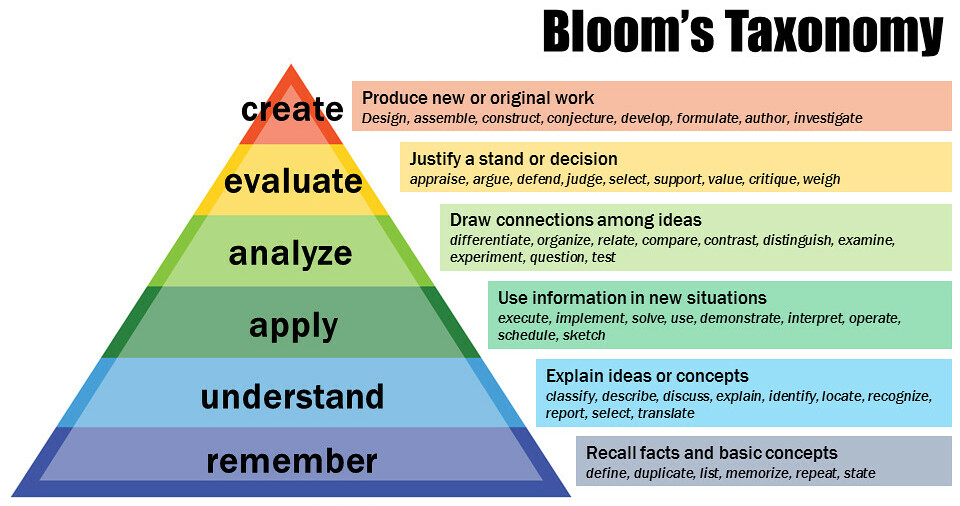1.4 Bloom’s Taxonomy
Erin Thomas, MFA
Thinking Deeply
In 1956, Benjamin Bloom with collaborators Max Englehart, Edward Furst, Walter Hill, and David Krathwohl published a framework for categorizing educational goals: Taxonomy of Educational Objectives. Known as Bloom’s Taxonomy, this framework has been applied by generations of K-12 teachers and college instructors in their teaching. In 2001, a group of cognitive psychologists, curriculum theorists and instructional researchers, and testing and assessment specialists published a revision of Bloom’s Taxonomy, which is pictured below. This framework can help teachers develop learning goals and objectives, so that teachers and students understand the purpose of a lesson. Specifically, having an organized set of objectives helps teachers to accomplish the following:
- Plan and deliver appropriate instruction
- Design valid assessment tasks and strategies
- Ensure that instruction and assessment are aligned with the objectives[1]
Read through the graphic below. Think of some assignments in your past courses and how they relate to intellectual activities described on the diagram.

Table 1.3.1 provides some examples of classroom activities that may fit into the levels of Bloom’s Taxonomy.
Table 1.3.1: Bloom’s Taxonomy Action Verbs and Activities
| Remember | Understand | Apply | Analyze | Evaluate | Create |
|---|---|---|---|---|---|
| 1. Lecture 2. Visuals 3. Video 4. Audio 5. Examples 6. Illustrations 7. Analogies |
1. Questions 2. Discussion 3. Review 4. Test 5. Assessments 6. Reports 7. Presentations 8. Writing |
1. Exercises 2. Demonstrations 3. Projects 4. Sketches 5. Simulations 6. Role play 7. Teach-back |
1. Problems 2. Exercises 3. Case Studies 4. Discussions 5. Questions 6. Test |
1. Projects 2. Problems 3. Case Studies 4. Simulations 5. Appraisals 6. Critiques 7. Debates |
1. Develop plans 2. Creative exercises 3. Projects 4 Constructs[2] |
As a student, Bloom’s Taxonomy can help you understand that there are multiple levels of thinking. Reflect on the following on ideas and how they relate to your experiences with learning:
- Mastery of learning requires students to move beyond rote memorization of concepts.
- Complex tasks require complex thinking, which often stretch your abilities and cause mental discomfort.
- As you advance through the levels of thinking, you create more neural networks and enhance what you are able to accomplish with new knowledge and information.
Students learn best by thinking deeply, and throughout this course we will give you opportunities to engage in activities at different levels of Bloom’s Taxonomy. However, it is ultimately up to you how effectively you integrate these strategies into your process. We are accustomed to consuming information in the way we eat junk food out of a vending machine: we want it quick, convenient, and shallow. By developing your ability to concentrate and manage your attention, you will get more out of the exercises of this workbook. The ultimate goal is not just to introduce you to new strategies, but to create new habits and ultimately transform the way you think.
Instructions
- Consider the following questions:
- Think of 3 assignments that you have completed this semester. Using the table, explain the levels of thinking on Bloom’s Taxonomy that you used to complete these assignments.
- In your opinion, how can deep thinking improve your ability to retain the information that you learn? Explain, using an example of learning from your life.
Media Attributions
- Bloom’s_Revised_Taxonomy © Vanderbuilt Center for Teaching is licensed under a CC BY (Attribution) license
- Armstrong, P. (2010). Bloom’s Taxonomy. Vanderbilt University Center for Teaching. Retrieved July 22, 2021 from https://cft.vanderbilt.edu/guides-sub-pages/blooms-taxonomy/ ↵
- Hokkanen, I. (n.d.). Bloom taxonomy action verbs and activities. Retrieved July 28, 2025, from chrome-extension://efaidnbmnnnibpcajpcglclefindmkaj/https://gme.med.ufl.edu/wordpress/files/2020/12/bloom-taxonomy-action-verbs-and-activities-1-638.pdf ↵

